- Home
- John Barth
Final Fridays Page 24
Final Fridays Read online
Page 24
Enjoyed too our professional path-crossings through the remainder of the century: at one another’s universities (most though not all of us were professors, typically though not necessarily of literature and/or its writing), at conferences and other literary functions here and there in our republic and abroad. As Omensetter was followed by the story-collection In the Heart of the Heart of the Country (which I liked even more than its so-impressive predecessor) and that by Willie Masters’ Lonesome Wife (which if possible I enjoyed more yet: the most formally sportive item in Gass’s oeuvre) and the several splendid essay-collections, I came to know their author a bit, sharing reading/ lecture platforms with him in Buffalo, St. Louis, and Baltimore, in New York and North Dakota, in Germany and in Spain. Admired his presence, onstage and off. Admired his formidable intelligence and learning, his commitment to teaching (“I’ll probably keep at it till I drop,” he remarked to me upon my own academic retirement in 1995, “and then I’ll have myself stuffed and go on teaching”), his obiter dicta (“I’ll never do a fiction-writing workshop,” he once vowed to me: “When I’m reading a bad student paper on Plato, at least I’m thinking about Plato; but when I’m reading a bad student short story about trout fishing, I’m not thinking about anything.”).
Admired and admire most of all, of course, the writing: in the fiction, those inhospitable landscapes and typically pathetic-when-not-monstrous characters, marvelously rendered into language; in the essays, the play of mind and wide-ranging erudition lightly deployed. And in both, the prose, the prose—in particular (if I were obliged to single out one element or aspect for special commendation, which I am not but nevertheless will) the similes: those homely yet showstopping similes, still the Gass trademark for this admiring reader, which stick in my memory long after I’ve forgotten which work they’re from and what subtle additional relevances they no doubt have to their context. A character’s hands “quick as cats,” drafts of air that “cruise like fish through the hollow rooms,” a feeling “like the loneliness of overshoes or someone else’s cough,” a face “like a mail-order ax,” “wires where sparrows sit like fists,” an argument “as sinuous and tough as ivy”—and those drowsing pickles....
One can sieve troves of such gems from Gass’s pages. Indeed, the narrator of “In the Heart of the Heart of the Country” self-deprecatingly remarks, “Similes dangle like baubles from me.” Not so: A Bill Gass simile does not dangle; it is of a piece with the cadence of its sentence, the stuff of its speaker, the situational moment. And it is no bauble, but an unostentatious gemstone: a diamond not really in the rough, but cunningly polished to look rough, if you follow me. A Bill Gass simile is like . . . is like . . .
TO THE RESCUE, maestro!
The Last Introduction (memorial tribute to Joseph Heller)
Three times, at approximate 10-year intervals, it was my pleasure to introduce Joseph Heller to university audiences: first in the tempestuous High 1960s at the State University of New York at Buffalo, and twice later—in the post-Nixon 1970s and again in the twilight of the Reagan ’80s—at Johns Hopkins. These professional path-crossings, along with our having each taught earlier at Penn State in our apprentice days and been often subsequently categorized together as “Black Humorists” back when that label was in fashion, added an extra fillip of literary comradeship to our cordial acquaintance, despite whatever differences between Joe’s muse and mine. What follows is adapted from the last of those three introductions, delivered on October 4, 1988, when Joe and his wife Valerie were book-touring for his just-published “Rembrandt” novel, Picture This. Upon Joe’s death 11 years later (in December 1999, at age 76), Valerie Heller projected a volume of memorial tributes to her husband from sundry of his friends and associates, and in keeping with our established pattern of one Heller-intro per decade, I contributed this one. If introductions had titles, I would call it
APPLAUDING JOE
Joseph Heller has done at least three literary things that I believe any of his fellow novelists would applaud. I certainly do.
To begin with, his first novel (Catch-22, published in 1961 and never out of print since) managed to be at one and the same time artistically serious, enormously funny (the correct adverb, I think, since its humor addresses such enormities as war, military bureaucracy, grisly chance, and ubiquitous death), blackly cynical (the novel is part of the canon of what came to be called Black Humor), and yet tremendously popular and influential. How gratifying it must be, for a serious American novelist at the close of the 20th century, to be read by millions of people who don’t happen to be what Thomas Mann called “early Christians”: devoted worshippers of literature. I would envy Joe that, were I the envying sort; in any case, I vigorously applaud.
Second, as anybody who lived through the American 1960s knows, that same novel played a certain role in the history of that decade, when Heller’s Yossarian became a tutelary saint of the anti-Vietnam-war movement. I suspect that even those of us who have no a priori ambition to change the world with our art would be secretly pleased to see reality give way a little bit in the face of our fiction—particularly if the effect is benign, as it certainly was in this instance. Enviable: I applaud.
And third, who among us would not be gratified, even if our writing has no effect whatever on the course of history, to live to see it have at least a small effect on language? Perhaps what I most nearly envy Joe Heller is that his term “Catch-22” has come to be used so often, by so many people of all sorts, whether they’ve read the novel or not, to describe a not-uncommon phenomenon that we didn’t have a ready name for until Joe gave us one. We hear it used in the press, by government leaders here and abroad, by anybody caught in such a catch. Not many authors manage to put their trademark on items of our common vocabulary: I think of Charles Dickens, Lewis Carroll, George Orwell, Anne Tyler, Joseph Heller—and I applaud.
BUT OF COURSE Catch-22 is only the first book in Heller’s oeuvre. Five-and-a-half others have followed it1 (No Laughing Matter, the non-fictional account of his struggle with Guillain-Barré Syndrome, was coauthored with his friend Speed Vogel): books with characters ranging from Henry Kissinger to God. All are comic, even the remorseless Something Happened and the harrowing No Laughing Matter. None is cheering. Heller truly is a Black Humorist, and his new novel, Picture This, may be the darkest of the lot: entertaining indeed; profoundly skeptical if not flat-out cynical in its views of history, art, and classical philosophy; extraordinary in its subject matter; and (like all of Heller’s books) cunning in its architecture. Its author is passing through Baltimore just now on its behalf, and very generously agreed to stop by Johns Hopkins, which he hasn’t visited for a number of years, and to say hello again to our Writing Seminars.
Welcome back, Joe.
(And au revoir, much-missed comrade.)
Remembering John Updike
Written in 2010 for the John Updike Society’s memorial volume Remembrances of John Updike, edited by Professor Jack De Bellis of Lehigh University.
ALTHOUGH IT WAS not my privilege to be among John Updike’s many close friends, he and I were amiable and mutually respectful literary acquaintances for decades. I enjoyed his so-abundant and eloquent publications, from the earliest fiction, verse, and critical essays right through the touching final items written in his life’s last weeks. We regularly sent each other copies of our books as they appeared, and our several path-crossings were invariably pleasant, often memorable occasions.
Unlike his friend John Cheever, for example, who had no use for the likes of Barth, Barthelme, and other “innovative” fictioneers, Updike was able to admire writing very different from his own finely-honed suburban-American realism (from which he himself ventured boldly from time to time, as in the novel Gertrude and Claudius and his several books for children): He supported my election in 1974 to the American Academy of Arts and Letters, and later seconded my nomination of the brilliant (and quite innovative) novelist Richard Powers to membership in that august body. In the ear
ly 1970s, when I was professoring for a year at Boston University, my wife and I visited John in Ipswich: We strolled the nearby beach with him (New England waters too chilly for us tidewater Marylanders!), and—he having learned that I shared his fondness for playing early recorder music—his friend Peter Davison (poetry editor of The Atlantic Monthly) joined us for an evening of Elizabethan trios. That same year, John visited our temporary lodgings near Radcliffe College in Cambridge for dinner with Shelly and me and the poets George and Kathy Starbuck, followed by a spirited but friendly four-against-one argument about the Vietnam war (John granted our objections to it, but supported the administration’s position anyhow). And not long thereafter, when he was living in Boston between marriages, I urged him to have another go at teaching: the same visiting-professorship in fiction-writing at Boston U. that I was currently enjoying and that Donald Barthelme would take an initiatory crack at after the Barths had shifted from Boston back to Buffalo and thence to Baltimore for the remainder of our academic careers. Perhaps to his own surprise, Barthelme found the experience agreeable, and taught regularly thereafter in Houston until his all-too-early death. John, however, recoiled from Academia as had I from the chilly waters of New England: In the early 1960s he’d taught one course at the Harvard Summer School, quite disliked the experience, and (except to fill in for the temporarily indisposed Cheever one day in that same B.U. visiting professorship) never taught another class.
Our relations, however, remained warm, and once I was established in the Johns Hopkins Writing Seminars I persuaded him to have a go at something else to which he’d been habitually disinclined: John resisted public readings, but when he mentioned in a letter that he was seriously hooked up with a new woman, at my invitation he brought Martha down to Baltimore for what he happily declared to be their first public outing together. He gave a delightful reading at Hopkins that included, at Shelly’s and my request, his story “Lifeguard” (one of our favorites), and we guided the new couple through such standard Baltimore sight-sees as the Inner Harbor area and the haunts of Edgar Allan Poe.
Over the ensuing decades, our connection was limited mainly to holiday greetings (we always relished his Christmas-card verses), first-edition swaps (more from that so-prolific John than from this less-prolific one), and occasional Academy-nomination business. Like many another of his admirers, Shelly and I were annually chagrined at his being passed over for the Nobel Prize in Literature: an award to which he would have done as much honor as it to him. In December 2008 we were dismayed to learn of his illness in what—incredibly!—turned out to be his final Christmas-note, and were much moved some months thereafter to receive from his publisher John’s final three volumesa—the new edition of his Maples stories, the all-new story-collection My Father’s Tears, and his fine last verse-collection Endpoint, with its so-touching final poem “To Martha, on Her Birthday, After Her Cataract Operation”—together with a note from his editor, Kenneth Schneider, addressed to both of us and saying John would have wanted you to have these.
We thank you for that, Mr. Schneider. And even more we thank you, John Updike, for being the miracle that you were—and will remain.
The Judge’s Jokes: Souvenirs of My Father, the After-Banquet Speaker1
—cornflakes in washing machine / coon hound
—“Living Bra”? What’ll you feed it?
—“I never kissed the Blarney Stone; I only sat on it.”
MY FATHER, WHOSE first and last names I share—John Jacob “Whitey” Barth (1894–1980), late of Cambridge, on Maryland’s lower Eastern Shore—was himself the fifth of six children: four girls and two boys born in the 19th century’s closing decades to a German immigrant stone-worker and his wife. Having crossed from Bremerhaven to Baltimore and found both employment and a bride in that city’s populous German-immigrant community, Herman Wilhelm Barth then crossed Chesapeake Bay with her to Cambridge and established himself there in the tombstone trade. His older son and namesake, evidently the favorite, aspired beyond his father’s craft: Re-crossing the Bay after high school to study sculpting at the Maryland Institute of Art, young Herman (his middle name Englished from “Wilhelm” to “William”) filled his parents’ East Cambridge house with plaster replicas of classical and Beaux Arts statuary, just when International Modernism was hitting the American scene in the 1913 Armory Show. Whether he would have been influenced by that radical new aesthetic, we’ll never know: In World War I he went to France with the AEF to fight his father’s fatherland and died there in the great flu pandemic of 1918, two months before the Armistice.
In contrast to Herman’s ambition (and parental support, presumably: the Maryland Institute is not tuition-free, and few youngsters in that place, time, and class went off to higher education), his kid brother’s was less lofty. As a small boy helping out in the stoneshop, my dad was put to work polishing a flat slab of marble with a piece of railroad iron; as he would tell the story later, chuckling, to his own children, he managed to mash a finger, was sent home crying, and never went back, at least not to apprentice himself to his father’s and elder brother’s trade. At age 16, for reasons never explained to us (but I don’t recall our ever asking for explanation), he dropped out of high school and went to work in a little candy-and-soda shop a few blocks from home, near the bustling crab-and-oyster processing plants on the creek that divided East Cambridge from the town’s business section and other residential wards. In 1917 he too enlisted, and spent the war years as a ground-crewman in the Army’s fledgling “Aviation Section”—but he got no farther from his home town than Langley Field in nearby Virginia, and upon his discharge was content to come back to the bereft family homestead (where he was now the Only Son) and his former employment.
In which, unglamorous as it was compared to Art, he did well—and who knows whether his sadly short-lived brother would have scored as a sculptor or wound up carving tombstones like his dad? Having mastered as a teenager the ins and outs of the candy and soda-fountain business, in his and the century’s twenties my father set up shop for himself, first as a wholesaler (his earliest printed stationery, now browned and crisped with age, is headed JOHN J. BARTH, Wholesale High Grade Chocolates and Specialties, Cambridge, Md) and soon after as a retail shopkeeper in his own soda-fountain/lunchroom /candy-store “uptown” on Race Street, the town’s main business section. His later letterheads read WHITEY’S, John J. Barth, Cambridge, Md, and in time JOHN J. BARTH, Fine Candy Since 1922, Cambridge, Md. In addition to Whitman’s Chocolates and assorted other candies, the store featured Dolley Madison ice cream, sundaes and sodas (no bottled drinks), cold sandwiches made at the counter (he didn’t like cooking-odors on the premises), and soups made at home by our mom and reheated at the store on a small backroom stove. But the showcases of candy (mainly chocolate) were his chief interest: The business’s name was Whitey’s Candyland, but everybody called it simply Whitey’s.
Whitey’s? On Race Street? In the then totally segregated South?
Race Street, Cambridge MD, 1936, with Whitey’s sign near center.
We’ll get to that—though I don’t recall our ever asking whence the nickname, either, which he carried from boyhood. Meanwhile it’s 1922: The young shopkeeper meets and marries a local young milliner working in a hat-shop a few doors down from the Candyland; they move into a two-story white clapboard house next door to his parents, one block from the broad Choptank River and the hospital where over the next several years their children will be born, and where nearly 60 years later, still a resident of that house, at age 85 he’ll breathe his last. Through the intervening half-dozen decades, despite a youthful sinus infection that in those pre-antibiotic days left him severely hearing-impaired for the rest of his life, he thrived in the small town and marsh-rich rural county that he had no interest in leaving (told by his doctor that the only hope for relief from his chronic sinusitis was a less humid climate, Dad replied that he’d rather be sick on the Eastern Shore than healthy anywhere else). He was gregarious, outgoi
ng, and community-spirited: In addition to storekeeping from morning till night six days a week every week of the year, he served as an elected judge of the Dorchester County Orphans Court every Tuesday afternoon for a record-breaking 44 years, was a devoted member of the town’s volunteer fire company as well as an organizer of similar companies in the county’s smaller towns, and an American Legionnaire who not only marched with his fellow veterans in Cambridge’s annual Armistice Day parade but became the chief organizer of those elaborate events. By comparison to his life, mine (literary and academic) seems almost reclusively detached, its radius much wider but its roots—in serial dwelling-places from Pennsylvania and upstate New York to Maryland and south-west Florida—less deep.
Because those volunteer fire companies, understandably, are tightly bonded social clubs as well as indispensable community-service outfits, in addition to their weekly meetings they have members-only banquets and fund-raising public barbecues and ham-and-oyster suppers. It was as the jocular after-dinner speaker at those banquets, in a dozen-plus venues around the county—his own beloved Rescue Fire Company and those others he’d helped organize—that Judge Whitey came into his own as an entertainer, in demand year after year: never a clown, but a humorist locally renowned for his joke-telling from at least the early 1940s until his death in February 1980, just a month before his scheduled appearance at the RFC’s 37th Annual Memorial Banquet.

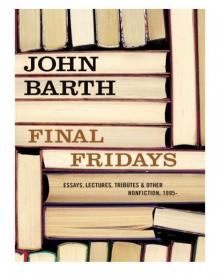 Final Fridays
Final Fridays Where Three Roads Meet: Novellas
Where Three Roads Meet: Novellas Every Third Thought: A Novel in Five Seasons
Every Third Thought: A Novel in Five Seasons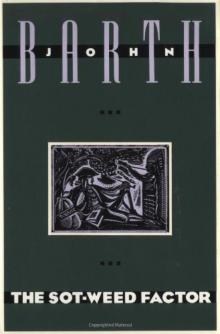 The Sot-Weed Factor
The Sot-Weed Factor The Friday Book
The Friday Book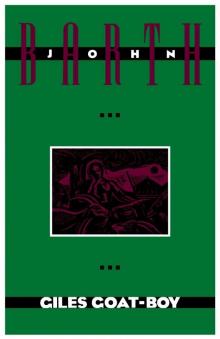 Giles Goat Boy
Giles Goat Boy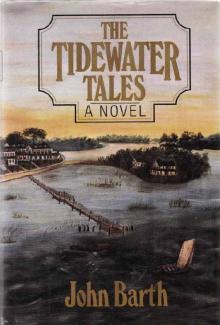 The Tidewater Tales
The Tidewater Tales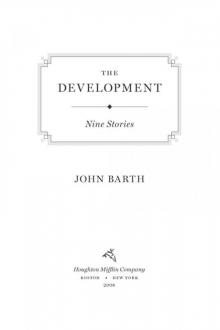 The Development
The Development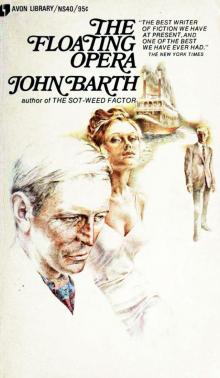 The Floating Opera
The Floating Opera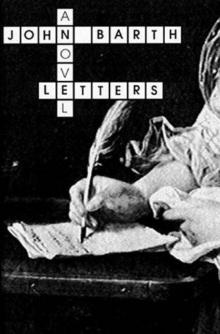 Letters
Letters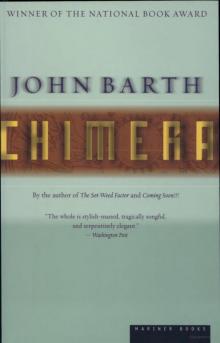 Chimera
Chimera Where Three Roads Meet
Where Three Roads Meet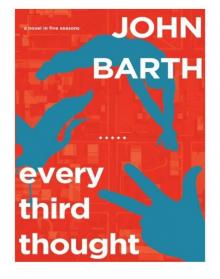 Every Third Thought
Every Third Thought